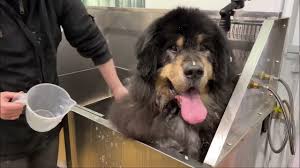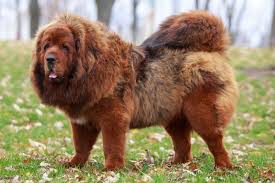The Tibetan Mastiff dog is a brave, fearless, patient, even-tempered dog, extremely devoted to its own family. If left outside at night, has a tendency to bark, but is peaceful inside.
It is a superb flock protector and will fight viciously off wolves, leopards, or any other animal that tries to approach its flock. Although it takes longer to mature than the usual breed, it is simple to housebreak.
To keep the Tibetan Mastiff from becoming overly stubborn, overly protective, and territorial, it needs a tough, confident, consistent leader.
The desire to please their owners is quite great in the Tibetan mastiff dogs. When among children, they are caring, but if not properly socialized, they can mistrust and be reserved about strangers.
This Mastiff naturally protects its family and their possessions. It needs to be carefully and equitably raised until adulthood.
A steady, trained dog often gets along nicely with other pets that aren’t dogs. If the owners are able to convey to them that fighting is an undesirable behavior, they may be able to get along with other dogs.
If Tibetan Mastiffs think they are smarter than their owners, they won’t listen. Owners must exude an inherent air of power in their behavior.
This dog is being trained with the goal of becoming the pack leader. A dog’s basic impulse is to establish order in its group. When humans and dogs coexist, we take on the role of the pack. Under a single leader, the entire pack works together. Rules and boundaries are established.
The humans, not the dogs, must be the ones making the decisions. Your relationship with your dog can only be a perfect success if you do that.
When owners are calm but adamant in asserting their dominance over the dog, and the dog is well-trained, socialized, and exercised, it can become a wonderful family pet.
This breed needs a knowledgeable owner, they are prone to ear infections, skin disorders, thyroid issues, and hip deformity.
There is a fatal hereditary condition known as Canine Inherited Demyelinative Neuropathy (CIDN).
Puppies with the illness will start to show symptoms between 7 and 10 weeks of age, and they will perish away by 4 months.
Every day walks are necessary for the Tibetan Mastiff. While on the walk, the dog must be trained to heel next to or behind the person holding the lead since, in a dog’s eyes, the human must always be the one in charge.
Avoid overdoing the physical aspect of the young dog’s life to prevent the bones, muscles, and joints from being overworked during the growth stage. However, in order to satiate their migratory urge, they will still need to walk every day.
Despite the fact that both the Do-khyi and the Tsang-khyi are frequently born in the same litter, some breeders have divided the Tibetan Mastiff into two varieties.
Tsang-khyi, which translates to “dog from Tsang,” is referred to as a “monastery” style. It has more facial wrinkles and is taller and heavier boned. The Do-khyi or “nomad” kind has less wrinkling and is slimmer.
The head is large, massive, and strong, albeit a little wrinkly. When viewed from all angles, the broad muzzle is square. The teeth come together in a level or scissors bite. Typically, the lower lip is hidden by the upper lip.
The V-shaped pendant ears hang close to the head in front. The dewlap is moderate, and the neck is muscularly arched. Males have a dewlap that is more noticeable than females have.
There is a level topline. Curled over the back is the feathery tail. The feathering on the front legs is straight.
There may be feathering between the toes and cat-like feet. Sometimes dewclaws are removed. With a massive mane wrapping over the neck and shorter hair on the head, the double coat is huge and dense.
Black, brown, and blue-gray are the available coat colors, all with or without tan markings and varied gold tones. White markings are another possibility.
Read Also: Finnish Lapphund Dogs: Description and Complete Care Guide
How To Groom Your Tibetan Mastiff Dogs

1. Brushing
Using a slicker brush many times a week will assist to remove dead hair and stop new tangles from forming on your Tibetan Mastiff.
After brushing them with the slicker brush, find and remove any mats or tangles with a wide-tooth comb.
You might need to apply some detangling spray or a little conditioner if you run into some knots that won’t come out with a comb.
2. Brush Their Teeth Regularly
Brushing your Tibetan Mastiff’s teeth on a regular basis will help to prevent plaque and tartar buildup and freshen its breath.
Brush the dog’s teeth twice a week with a regular toothbrush, but make sure to use dog toothpaste because human toothpaste can make dogs sick if they ingest it.
3. Ear Care
If the ears on your Mastiff aren’t regularly cleaned, they’ll gather dirt and other debris, become infected, and possibly even lose their ability to hear.
Use canine ear cleaning solution once a month to clean the dog’s ears. Always use cotton balls to blot up any extra solution, and make sure you adhere to the manufacturer’s instructions.
4. Nail Clipping
A trained groomer is needed for this extremely delicate process. However, you must clip your dog’s nails and not merely take it to a groomer as a duty as a dog owner. To avoid hurting them, use caution when trimming their nails.

